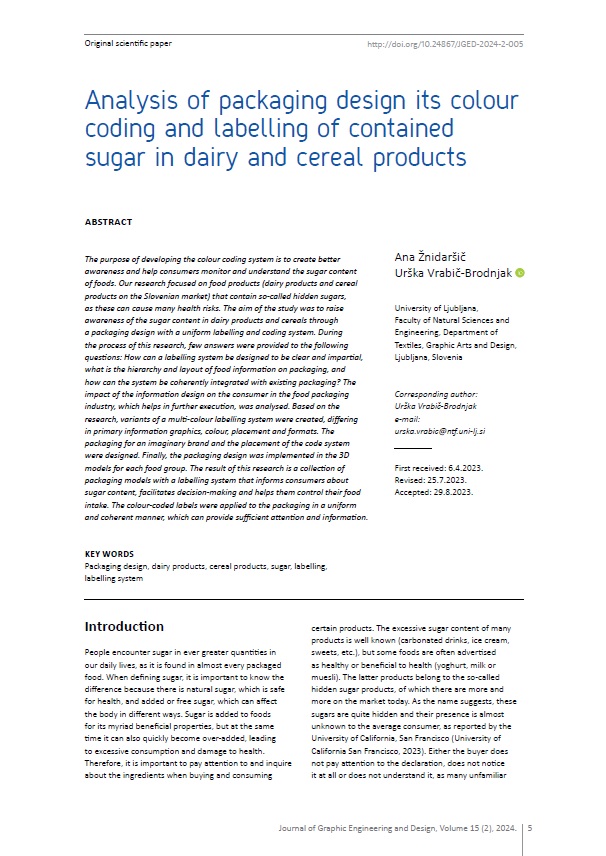Analysis of packaging design its colour coding and labelling of contained sugar in dairy and cereal products

Published 2024-06-01
abstract views: 498 // Full text article (PDF): 391
Keywords
- Packaging design,
- dairy products,
- cereal products,
- sugar,,
- labelling
- labelling system ...More
How to Cite
Abstract
The purpose of developing the colour coding system is to create better awareness and help consumers monitor and understand the sugar content of foods. Our research focused on food products (dairy products and cereal products on the Slovenian market) that contain so-called hidden sugars, as these can cause many health risks. The aim of the study was to raise awareness of the sugar content in dairy products and cereals through a packaging design with a uniform labelling and coding system. During the process of this research, few answers were provided to the following questions: How can a labelling system be designed to be clear and impartial,
what is the hierarchy and layout of food information on packaging, and how can the system be coherently integrated with existing packaging? The impact of the information design on the consumer in the food packaging industry, which helps in further execution, was analysed. Based on the research, variants of a multi-colour labelling system were created, differing in primary information graphics, colour, placement and formats. The packaging for an imaginary brand and the placement of the code system were designed. Finally, the packaging design was implemented in the 3D models for each food group. The result of this research is a collection of packaging models with a labelling system that informs consumers about sugar content, facilitates decision-making and helps them control their food intake. The colour-coded labels were applied to the packaging in a uniform and coherent manner, which can provide sufficient attention and information.
Dimensions Citation Metrics
References
- Erickson, J. & Slavin, J. (2015) Total, Added, and Free Sugars: Are Restrictive Guidelines Science-Based or Achievable?. Nutrients. 7 (4), 2866–2878. Available from: doi: 10.3390/nu7042866
- Eržen, N. (2014) Validation of nutrition profiling models based on selected dairy products and similar foods of plant origin. PhD thesis. University of Ljubljana.
- Goldfein, K. R. & Slavin, J. L. (2015) Why Sugar Is Added to Food: Food Science 101. Comprehensive Reviews in Food Science and Food Safety. 14 (5), 644–656. Available from: doi: 10.1111/1541-4337.12151
- Huang, L. & Lu, J. (2015) Eat with your eyes: Package color influences the expectation of food taste and healthiness moderated by external
- eating. Marketing Management. 25 (2), 71-87.
- Jones, A., Neal, B., Reeve, B., Mhurchu, C. N. & Thow, A.M. (2019) Front-of-pack nutrition labelling to promote healthier diets: current practice and opportunities to strengthen regulation worldwide. BMJ global health. 4 (6). Available from: doi: 10.1136/bmjgh-2019-001882
- Scapin, T., Fernandes, A. C., Curioni, C. C., Pettigrew, S., Neal, B., Coyle, D. H., Rodrigues, V. M., Bernardo, G. L., Uggioni, P. L. & Proença, R. P. C. (2020) Influence of sugar label formats on consumer understanding and amount of sugar in food choices: a systematic review and meta-analyses. Nutrition Reviews. 79 (7), 788–801. Available from: doi: 10.1093/nutrit/nuaa108
- Tinker, M. A. (1963) Legibility of Print. Arnes, Iowa State University Press. U.S. Food & Drug Administration. (2023) The Lows and Highs of Percent Daily Value on the New Nutrition Facts Label. Available from: https:// www.fda.gov/food/new-nutrition-facts-label/
- lows-and-highs-percent-daily-value-new-nutrition-facts-label [Accessed 28th March 2023]
- University of California San Francisco (2023) Hidden in Plain Sight. Available from: https:// sugarscience.ucsf.edu/hidden-in-plain-sight/#.
- ZBrqkfaZNPY [Accessed 2nd March 2023]
- Wąsowicz, G., Styśko-Kunkowska, M. & Grunert, K. G (2015) The meaning of colours in nutrition labelling in the context of expert and consumer
- criteria of evaluating food product healthfulness. Journal of Health Psychology. 20 (6), 907–920. Available from: doi: 10.1177/1359105315580251
- Weingerl, P., Nedeljković, U. & Pušnik, N. (2022) Visibility and legibility of five-letter words in different experimental conditions. Journal of Graphic Engineering and Design. 13 (3), 51–58. Available from: doi: 10.24867/JGED-2022-3-051
- World Health Organization (2015) WHO calls on countries to reduce sugars intake among adults and children. Available from: https://www.who.int/news/item/04-03-2015-who-calls-on-countries-to-reduce-sugars-intake-among-adultsand-children [Accessed 29th March 2023]
- Yeung, C. A., Goodfellow, A. & Flanagan, L. (2015) The
- Truth about Sugar. Dental Update. 42 (6), 507–12.
- Available from: doi: 10.12968/denu.2015.42.6.507
- Zupančič, N. (2020) Sugar in pre-packaged
- foods and in diet among children in Slovenia.
- PhD thesis. University of Ljubljana.


